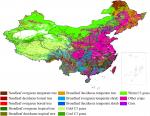Citation:

摘要:
To evaluate the variations in temporal and spatial distribution of biogenic volatile organic compound (BVOC) emissions in China, historical BVOC emission inventories at a spatial resolution of 36 km × 36 km for the period of 1981–2003 were developed firstly. Based on the time-varying statistical data and Vegetation Atlas of China (1:1,000,000), emissions of isoprene, 37 monoterpenes, 32 sesquiterpenes, and other volatile organic compounds (OVOCs) were estimated using MEGANv2.1 driven by WRF model. Results show China's BVOC emissions had increased by 28.01% at an annual average rate of 1.27% from 37.89 Tg in 1981 to 48.50 Tg in 2003. Emissions of isoprene, monoterpenes, sesquiterpenes, and OVOCs had increased by 41.60%, 34.78%, 41.05%, and 4.89%, respectively. With fixed meteorological variables, the estimated BVOC emissions would increase by 19.25%, resulting from the increasing of vegetation biomass during the last 23 years. On average, isoprene, monoterpenes, sesquiterpenes, and OVOCs were responsible for 52.40%, 12.73%, 2.58%, and 32.29% of the national BVOC emissions, respectively. β-pinene and α-pinene, farnesene and caryophyllene were the largest contributors to the total monoterpene and sesquiterpene emissions, respectively. The highest emissions were found over northeastern, southeastern, southwestern China, Qinling Mountain, and Hainan and Taiwan provinces. The regions with high emissions had been expanding over the years, especially in the Changbai Mountain, southern China, and southwestern forest regions. The lowest emissions in southern China occurred in 1984–1988. Almost all the provinces had experienced increasing emissions, but their contributions to the national emissions differed significantly over the past 23 years. Yunnan, Guangxi, Heilongjiang, Jiangxi, Fujian, Guangdong, and Sichuan provinces always dominated the national BVOC emissions, excluding in 1977–1981, when the three northeastern provinces had relatively lower emissions.
